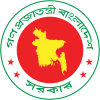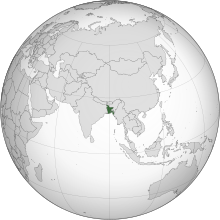
A | B | C | D | E | F | G | H | CH | I | J | K | L | M | N | O | P | Q | R | S | T | U | V | W | X | Y | Z | 0 | 1 | 2 | 3 | 4 | 5 | 6 | 7 | 8 | 9
Bangladesh,[a] officially the People's Republic of Bangladesh,[b] is a country in South Asia. It is the eighth-most populous country in the world and is among the most densely populated countries with a population of nearly 170 million in an area of 148,460 square kilometres (57,320 sq mi). Bangladesh shares land borders with India to the north, west, and east, and Myanmar to the southeast. To the south, it has a coastline along the Bay of Bengal. It is narrowly separated from Bhutan and Nepal by the Siliguri Corridor, and from China by the mountainous Indian state of Sikkim in the north. Dhaka, the capital and largest city, is the nation's political, financial, and cultural centre. Chittagong, the second-largest city, is the busiest port on the Bay of Bengal. The official language of Bangladesh is Bengali.
Bangladesh forms the sovereign part of the historic and ethnolinguistic region of Bengal, which was divided during the Partition of India in 1947 as part of a Muslim union with Pakistan, which it separated from in 1971.[24] The country has a Bengali Muslim majority. Ancient Bengal was known as Gangaridai and was a bastion of pre-Islamic kingdoms. Muslim conquests after 1204 heralded the sultanate and Mughal periods, during which an independent Bengal Sultanate and a wealthy Mughal Bengal transformed the region into an important centre of regional affairs, trade, and diplomacy. After the Battle of Plassey in 1757, the maximum extent of British Bengal stretched from the Khyber Pass in the west to Singapore in the east.[25][26] The creation of Eastern Bengal and Assam in 1905 set a precedent for the emergence of Bangladesh. The All India Muslim League was founded in Dhaka in 1906.[27] In 1940, the first Prime Minister of Bengal, A. K. Fazlul Huq, supported the Lahore Resolution. Before the partition of Bengal, a Bengali sovereign state was first proposed by premier H. S. Suhrawardy. A referendum and the announcement of the Radcliffe Line established the present-day territorial boundary.
In 1947, East Bengal became the most populous province in the Dominion of Pakistan. It was renamed as East Pakistan, with Dhaka becoming the country's legislative capital. The Bengali Language Movement in 1952; the East Bengali legislative election, 1954; the 1958 Pakistani coup d'état; the six point movement of 1966; and the 1970 Pakistani general election resulted in the rise of Bengali nationalism and pro-democracy movements. The refusal of the Pakistani military junta to transfer power to the Awami League, led by Sheikh Mujibur Rahman, led to the Bangladesh Liberation War in 1971. The Mukti Bahini, aided by India, waged a successful armed revolution. The conflict saw the Bangladeshi genocide and the massacre of pro-independence Bengali civilians, including intellectuals. The new state of Bangladesh became the first constitutionally secular state in South Asia in 1972.[28] Islam was declared the state religion in 1988.[29][30][31] In 2010, the Bangladesh Supreme Court reaffirmed secular principles in the constitution.[32]
A middle power in the Indo-Pacific,[33] Bangladesh is home to the sixth-most spoken language in the world, the third-largest Muslim-majority population in the world, and the second-largest economy in South Asia. It maintains the third-largest military in the region and is the largest contributor of personnel to UN peacekeeping operations.[34] Bangladesh is a unitary parliamentary republic based on the Westminster system. Bengalis make up 99% of the total population.[35] The country consists of eight divisions, 64 districts and 495 subdistricts, as well as the world's largest mangrove forest. It hosts one of the largest refugee populations in the world due to the Rohingya genocide.[36] Bangladesh faces many challenges, particularly corruption, political instability, overpopulation and effects of climate change. Bangladesh has been a leader within the Climate Vulnerable Forum. It hosts the headquarters of BIMSTEC. It is a founding member of the SAARC, as well as a member of the Organization of Islamic Cooperation and the Commonwealth of Nations.
Etymology
The etymology of Bangladesh ("Bengali country") can be traced to the early 20th century, when Bengali patriotic songs, such as Namo Namo Namo Bangladesh Momo by Kazi Nazrul Islam and Aaji Bangladesher Hridoy by Rabindranath Tagore, used the term.[37] Starting in the 1950s, Bengali nationalists used the term in political rallies in East Pakistan. The term Bangla is a major name for both the Bengal region and the Bengali language. The origins of the term Bangla are unclear, with theories pointing to a Bronze Age proto-Dravidian tribe,[38] and the Iron Age Vanga Kingdom.[39] The earliest known usage of the term is the Nesari plate in 805 AD. The term Vangala Desa is found in 11th-century South Indian records.[40][41] The term gained official status during the Sultanate of Bengal in the 14th century.[42][43] Shamsuddin Ilyas Shah proclaimed himself as the first "Shah of Bangala" in 1342.[42] The word Bangāl became the most common name for the region during the Islamic period.[44] 16th-century historian Abu'l-Fazl ibn Mubarak mentions in his Ain-i-Akbari that the addition of the suffix "al" came from the fact that the ancient rajahs of the land raised mounds of earth in lowlands at the foot of the hills which were called "al".[45] This is also mentioned in Ghulam Husain Salim's Riyaz-us-Salatin.[46] The Indo-Aryan suffix Desh is derived from the Sanskrit word deśha, which means "land" or "country". Hence, the name Bangladesh means "Land of Bengal" or "Country of Bengal".[41]
History
Ancient Bengal

Stone Age tools have been found in different parts of Bangladesh.[47] Remnants of Copper Age settlements date back 4,000 years. Ancient Bengal was settled by Austroasiatics, Tibeto-Burmans, Dravidians and Indo-Aryans in consecutive waves of migration.[48][49] Archaeological evidence confirms that by the second millennium BCE, rice-cultivating communities inhabited the region. By the 11th century, people lived in systemically aligned housing, buried their dead, and manufactured copper ornaments and black and red pottery.[50] The Ganges, Brahmaputra and Meghna rivers were natural arteries for communication and transportation,[50] and estuaries on the Bay of Bengal permitted maritime trade. The early Iron Age saw the development of metal weaponry, coinage, agriculture and irrigation.[50] Major urban settlements formed during the late Iron Age, in the mid-first millennium BCE,[51] when the Northern Black Polished Ware culture developed.[52] In 1879, Alexander Cunningham identified Mahasthangarh as the capital of the Pundra Kingdom mentioned in the Rigveda.[53][54] The oldest inscription in Bangladesh was found in Mahasthangarh and dates from the 3rd century BCE, written in the Brahmi script.[55]
Greek and Roman records of the ancient Gangaridai Kingdom, which (according to legend) deterred the invasion of Alexander the Great, are linked to the fort city in Wari-Bateshwar.[56][57] The site is also identified with the prosperous trading centre of Souanagoura listed on Ptolemy's world map.[58] Roman geographers noted a large seaport in southeastern Bengal, corresponding to the present-day Chittagong region.[59]
Ancient Buddhist and Hindu states which ruled Bangladesh included the Vanga, Samatata and Pundra kingdoms, the Mauryan and Gupta Empires, the Varman dynasty, Shashanka's kingdom, the Khadga and Candra dynasties, the Pala Empire, the Sena dynasty, the Harikela kingdom and the Deva dynasty. These states had well-developed currencies, banking, shipping, architecture, and art, and the ancient universities of Bikrampur and Mainamati hosted scholars from other parts of Asia. Gopala I was the first ever elected ruler of the region in 750 AD; he went on to form the Pala dynasty that ruled until 1161 AD, during which time Bengal prospered.[60] Xuanzang of China was a noted scholar who resided at the Somapura Mahavihara (the largest monastery in ancient India), and Atisa travelled from Bengal to Tibet to preach Buddhism. The earliest form of the Bengali language emerged during the eighth century. Seafarers in the Bay of Bengal sailed and traded with Southeast Asia[61] and exported Buddhist and Hindu cultures to the region since the early Christian era.[62]
Islamic Bengal
The early history of Islam in Bengal is divided into two phases: the period of maritime trade with Arabia and Persia between the 8th and 12th centuries, and centuries of Muslim dynastic rule after the Islamic conquest of Bengal. The writings of Al-Idrisi, Ibn Hawqal, Al-Masudi, Ibn Khordadbeh and Sulaiman record the maritime links between Arabia, Persia and Bengal.[63] Muslim trade with Bengal flourished after the fall of the Sasanian Empire and the Arab takeover of Persian trade routes. Much of this trade occurred with southeastern Bengal in areas east of the Meghna River. There is speculation regarding the presence of a Muslim community in Bangladesh as early as 690 CE; this is based on the discovery of one of South Asia's oldest mosques in northern Bangladesh.[64][65][63] Bengal was possibly used as a transit route to China by the earliest Muslims. Abbasid coins have been discovered in the archaeological ruins of Paharpur and Mainamati.[66]
Sultanate period

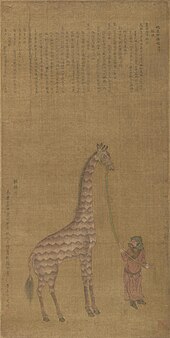
The Muslim conquest of Bengal began with the 1204 Ghurid expeditions led by Muhammad bin Bakhtiyar Khalji, who overran the Sena capital in Gauda and led the first Muslim army into Tibet.[50] Bengal was ruled by the Sultans of the Delhi Sultanate for a century under the Mamluk, Balban, and Tughluq dynasties. In the 14th century, three city-states emerged in Bengal, including Sonargaon led by Fakhruddin Mubarak Shah, Satgaon led by Shamsuddin Ilyas Shah and Lakhnauti led by Alauddin Ali Shah. These city-states were led by former governors who declared independence from Delhi. In 1352, Shamsuddin Ilyas Shah united the three city-states into a single, unitary and independent Bengal Sultanate. The new Sultan of Bengal forced the Sultan of Delhi to retreat during an invasion. The army of Ilyas Shah reached as far as Varanasi in the northwest, Kathmandu in the north, Kamarupa in the east, and Orissa in the south. During the reign of Sikandar Shah, Delhi recognised Bengal's independence. The Bengal Sultanate established a network of mint towns that acted as provincial capitals where the Sultan's currency was minted.[67] As Bengal became the easternmost frontier of the Islamic world, Bengali crystallized as an official court language, giving rise to various prominent writers. The sultanate was evolving as a commercialized and monetized economy and as a melting pot of Muslim political, mercantile and military elites.[68]
The two most prominent dynasties of the Bengal Sultanate were the Ilyas Shahi and Hussain Shahi dynasties. The reign of Sultan Ghiyasuddin Azam Shah saw the opening of diplomatic relations with Ming China. The reign of the Sultan Jalaluddin Muhammad Shah saw the development of Bengali architecture. During the early 15th century, Bengal aided the Restoration of Min Saw Mon in Arakan, which led to the latter becoming a tributary state of Bengal.[69][70] During the reign of Sultan Alauddin Hussain Shah, Bengali forces penetrated deep into the Brahmaputra Valley—and being led by Shah Ismail Ghazi, conquered Assam,[71] Jajnagar in Orissa,[72][73] the Jaunpur Sultanate, Pratapgarh Kingdom and the island of Chandradwip.[74][75][76][77][78] By 1500, Gaur became the fifth-most populous city in the world with a population of 200,000.[79][80] Maritime trade linked Bengal with China, Malacca, Sumatra, Brunei, Portuguese India, East Africa, Arabia, Persia, Mesopotamia, Yemen and the Maldives. The Sultans permitted the opening of the Portuguese settlement in Chittagong.
The disintegration of the Bengal Sultanate began with the intervention of the Suri Empire. Babur began invading Bengal after creating the Mughal Empire. The Bengal Sultanate collapsed with the overthrow of the Karrani dynasty during the reign of Akbar. However, the Bhati region of eastern Bengal continued to be ruled by aristocrats of the former Bengal Sultanate led by Isa Khan. They formed an independent federation called the Twelve Bhuiyans, with their capital in Sonargaon. The Bhuiyans ultimately succumbed to the Mughals after Musa Khan was defeated.
Mughal period

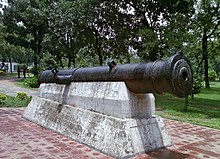
The Mughal Empire controlled Bengal by the 17th century. Musa Khan of Bengal, the last independent ruler of Sonargaon after resisting Mughal conquest for several years, was defeated and dethroned by Islam Khan Chishti, the army general of Mughal Emperor Jahangir. Islam Khan Chisti became the first Mughal Subahdar of Bengal. After his defeat, Musa Khan became loyal to the Mughal Empire. He actively participated in the conquest of Tripura and the suppression of revolt in Kamrup.[81]
The Mughals established Dhaka as a fort city and commercial metropolis. It was the capital of Bengal Subah for 75 years.[82] In 1666, the Mughals expelled the Arakanese from the port of Chittagong. Mughal Bengal attracted foreign traders for its muslin and silk goods, and the Armenians were a notable merchant community. A Portuguese settlement in Chittagong flourished in the southeast, and a Dutch settlement in Rajshahi existed in the north.[83] Bengal accounted for 40% of overall Dutch imports from Asia, including more than 50% of textiles and around 80% of raw silk.[84] The Bengal Subah, described as the Paradise of the Nations,[85] was a major global exporter,[84][86][87] a notable centre of worldwide industries such as muslin, cotton textiles, silk,[50] and shipbuilding.[88] Its citizens enjoyed one of the world's best living standards.[89]
During the 18th century, the Nawabs of Bengal became the region's de facto rulers, with a realm encompassing much of eastern South Asia. The Nawabs forged alliances with European colonial companies, making the region relatively prosperous early in the century. Bengal accounted for 50% of the gross domestic product of the empire. The Bengali economy relied on textile manufacturing, shipbuilding, saltpetre production, craftsmanship, and agricultural produce. Bengal was a major hub for international trade, renowned for its silk and cotton textiles worldwide.[90][50] Bengal was also famed as a shipbuilding hub.[91]

Eastern Bengal was a thriving melting pot with strong trade and cultural networks. It was a relatively prosperous part of the subcontinent and the centre of the Muslim population in the eastern subcontinent.[92] The Bengali Muslim population was a product of conversion and religious evolution,[50] and their pre-Islamic beliefs included elements of Buddhism and Hinduism. The construction of mosques, Islamic academies (madrasas), and Sufi monasteries (khanqahs) facilitated conversion, and Islamic cosmology played a significant role in developing Bengali Muslim society. Scholars have theorised that Bengalis were attracted to Islam by its egalitarian social order, which contrasted with the Hindu caste system.[93] By the 15th century, Muslim poets were widely writing in the Bengali language. Syncretic cults, such as the Baul movement, emerged on the fringes of Bengali Muslim society. The Persianate culture was significant in Bengal, where cities like Sonargaon became the easternmost centres of Persian influence.[94][95]
In 1756, nawab Siraj ud-Daulah sought to rein in the rising power of the British East India Company by revoking their free trade rights and demanding the dismantling of their fortification in Calcutta. A military conflict culminated in the Battle of Plassey on 23 June 1757.[96] Robert Clive exploited rivalries within the nawab's family, bribing Mir Jafar, the nawab's uncle and commander in chief, to ensure Siraj-ud-Daula's defeat.[97][98] Clive rewarded Mir Jafar by making him nawab in place of Siraj-ud-Daula, but henceforth the position was a figurehead appointed and controlled by the company.[99][100] Historians often describe the battle as "the beginning of British colonial rule in South Asia".[101]
The Company replaced Mir Jafar with his son-in-law, Mir Kasim, in 1760. Mir Kasim challenged British control by allying with Mughal emperor Shah Alam II and the Nawab of Awadh, Shuja ud-Daulah, but the company decisively defeated the three at the Battle of Buxar on 23 October 1764.[98][100] The resulting treaty made the Mughal emperor a puppet of the British and gave the company the right to collect taxes (diwani) in Bengal, Bihar, and Orissa, giving them de facto control of the region.[100][102] The Company used Bengal's tax revenue to expand their territorial possession in rest of South Asia.[102]
British Bengal
European arrivals

The Bengal Sultanate permitted the Portuguese settlement in Chittagong to be established in 1528. It became the first European colonial enclave in Bengal. The Bengal Sultanate lost control of Chittagong in 1531 after Arakan declared independence and the established Kingdom of Mrauk U. Portuguese ships from Goa and Malacca began frequenting the port city in the 16th century. The cartaz system was introduced and required all ships in the area to purchase naval trading licenses from the Portuguese. Portuguese piracy in the sea flourished. The nearby island of Sandwip was captured in 1602. In 1615, the Portuguese Navy defeated a joint fleet of the Dutch East India Company and the Arakanese near the coast of Chittagong.
After 1534, the Bengal Sultan allowed the Portuguese to create several settlements at Satgaon,[103] Hoogly, Bandel, and Dhaka. In 1535, the Portuguese allied with the Bengal Sultan and held the Teliagarhi pass 280 kilometres (170 mi) from Patna helping to avoid the invasion by the Mughals. By then several of the products came from Patna and the Portuguese send in traders, establishing a factory there in 1580.[104] The region accounted for 40% of Dutch imports from Asia.[84] In 1666, the Mughal government of Bengal led by viceroy Shaista Khan conquered Chittagong and expelled the Portuguese and Arakanese. The first Anglo-Mughal War took place in 1686.[105][106] By the 18th century, the British, French, Dutch, Danish and Austrian East India Companies built factories and trading posts across Bengal.[107][83][108][109] These companies obtained consent from the Nawabs of Bengal for trading rights and concessions. The British East India Company became the most powerful among the European companies in Bengal.
British East India Company rule

After the Battle of Plassey in 1757, Bengal was the first major part of the Indian subcontinent to be conquered by the British East India Company. Under the terms of the Treaty of Allahabad, the company would collect taxes on behalf of the Mughal emperor. The treaty was written by the Bengali Muslim diplomat I'tisam-ud-Din.[110] Under Company rule in India, Bengal was effectively ruled by the British on behalf of the Mughal emperor under Mughal suzerainty. The East India Company formed the Bengal Presidency, through which it administered the region until 1858. A notable aspect of the company's rule was the Permanent Settlement, which established the feudal zamindari system; in addition, Company policies led to the deindustrialisation of Bengal's textile industry.[111] The capital amassed by the East India Company in Bengal was invested in the emerging Industrial Revolution in Great Britain.[112][113] Economic mismanagement, alongside drought and a smallpox epidemic, directly led to the Great Bengal famine of 1770, which is estimated to have caused the deaths of millions of people.[114][115][116][117] Several rebellions broke out during the early 19th century, as Company rule had displaced the Muslim ruling class from power. A conservative Islamic cleric, Haji Shariatullah, sought to overthrow the British by propagating Islamic revivalism.[118] Several towns in Bangladesh participated in the Indian Rebellion of 1857.[119]
British Raj

After the 1857 rebellion, the British parliament transferred India's administration from the company to the British government. Direct rule by the Crown was imposed. The British government took over all the administrative functions of the Bengal Presidency.[120]
At its maximum extent, the Bengal Presidency stretched from the Khyber Pass to Southeast Asia. According to the British historian Rosie Llewellyn-Jones, the Bengal Presidency was an administrative jurisdiction introduced by the East India Company and staffed by British civil servants, aristocrats and military officers. It would stretch across the whole of northern India up to the Khyber Pass on the north-west frontier with Afghanistan. It spread eastwards to Burma and Singapore.[121] The Bengal Presidency was arguably the largest division of the British Empire. Its territorial evolution can be contrasted with the maximum extent of New Spain in the Spanish Empire, which stretched from the Philippines to the Americas.[122][123] The Bengal Presidency originally covered the territory gained from the Nawab of Bengal in the Battle of Plassey in 1757, including the regions of Bengal, Bihar and Orissa. It later stretched into areas of the Nawab of Awadh and the Mughal capital in Delhi after the Battle of Buxar in 1764. The Second Anglo-Sikh War resulted in the British conquest of Punjab, and the eventual extension of the presidency to the Khyber Pass. The Bengal Army played a key role in the expansion into North India up to the Khyber Pass. The native Gurkha infantry played a key role in the expansion of the presidency into the northeastern frontier regions of Assam. The East India Company also took control of coastal Burma, while English traders brought trading settlements in the Malacca Straits under British rule.
The Bengal Army played an important role in the expansion of British India. It was the largest among the presidency armies of Bengal, Bombay and Madras. It was made up of recruits from Bengal, Bihar and Oudh who served under British officers.[124] Its cavalry regiments included sowars from the former Mughal army.[125][126][127] The Bengal Army fought in the First Anglo-Afghan War, the First Anglo-Burmese War, the Second Anglo-Afghan War, the First Opium War, the Second Anglo-Burmese War, and the Third Anglo-Burmese War.

The rebellion of 1857 upended the government of British India. The Straits Settlements were separated from Bengal and became a crown colony in 1867.[128] By the turn of the century, most of northern India was reorganized into separate provinces, including Punjab, the United Provinces of Agra and Oudh, and Assam. In Burma, the Arakan region which bordered Bengal received many settlers. Wealthy farmers from Chittagong played an important role in developing the rice economy in Burma. Arakan Division was one of the top rice exporters in the world, due in large part to rich farmers from Chittagong.[129][130][131]
Within what is now Bangladesh, the trade networks of the British Empire brought traders and diplomats from far and wide.[132][133] Benjamin Joy was nominated by George Washington as the first U.S. consul and a consular agency was created for Chittagong.[133] In Dhaka, the Mughal legacy was reflected the city's courtly-genteel manners based on Mughal etiquette. Dhaka became home to communities of Armenians, Greeks, and Jews.[134] The British established several schools, colleges, and a university in what is now Bangladesh. Syed Ahmed Khan and Ram Mohan Roy promoted modern and liberal education in the subcontinent, inspiring the Aligarh movement[135] and the Bengal Renaissance.[136] During the late 19th century, novelists, social reformers, and feminists emerged from Muslim Bengali society. Electricity and municipal water systems were introduced in the 1890s; cinemas opened in many towns during the early 20th century. East Bengal's plantation economy was important to the British Empire, particularly its jute and tea. The British established tax-free river ports, such as the Port of Narayanganj, and large seaports like the Port of Chittagong.
Bengal had the highest gross domestic product in British India, with the summer capital of Shillong boasting the highest per capita income in the subcontinent.[137] Bengal was one of the first regions in Asia to have a railway, which began operating in 1862.[138] The main railway companies in the region were the Eastern Bengal Railway and Assam Bengal Railway. Railways competed with waterborne transport to become one of the main means of transport.[139]
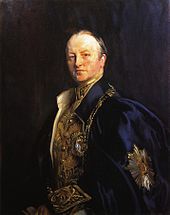
Supported by the Muslim aristocracy, the British government created the province of Eastern Bengal and Assam in 1905; the new province received increased investment in education, transport, and industry.[140] However, the first partition of Bengal created an uproar in Calcutta and the Indian National Congress. In response to growing Hindu nationalism, the All India Muslim League was formed in Dhaka in 1906. The British government reorganised the provinces in 1912, reuniting East and West Bengal and making Assam a second province.
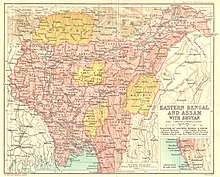
The Raj was slow to allow self-rule in the colonial subcontinent. It established the Bengal Legislative Council in 1862, and the council's native Bengali representation increased during the early 20th century. The Bengal Provincial Muslim League was formed in 1913 to advocate civil rights for Bengali Muslims. During the 1920s, the league was divided into factions supporting the Khilafat movement and favouring cooperation with the British to achieve self-rule. Segments of the Bengali elite supported Mustafa Kemal Atatürk's secularist forces.[141] In 1929, the All Bengal Tenants Association was formed in the Bengal Legislative Council to counter the influence of the Hindu landed gentry, and the Indian Independence and Pakistan Movements strengthened during the early 20th century. After the Morley-Minto Reforms and the diarchy era in the legislatures of British India, the British government promised limited provincial autonomy in 1935. The Bengal Legislative Assembly, British India's largest legislature, was established in 1937. British Burma was also separated from British India in 1937.

Although it won most seats in 1937, the Bengal Congress boycotted the legislature. A. K. Fazlul Huq of the Krishak Praja Party was elected as the first Prime Minister of Bengal. In 1940 Huq supported the Lahore Resolution, which envisaged independent states in the subcontinent's northwestern and eastern Muslim-majority regions. Huq was succeeded by Khawaja Nazimuddin, who grappled with the effects of the Burma Campaign, the Bengal famine of 1943 which claimed the lives of millions of people,[142] and the Quit India movement. During World War II, Bengal faced a possible Japanese invasion from Burma. Chittagong was bombed by the Japanese air force in April and May 1942.[143][144] Allied forces were stationed across eastern Bengal during the war.[145] In 1946, the Bengal Provincial Muslim League won the provincial election with the largest Muslim League mandate in British India. H. S. Suhrawardy, who made a final futile effort for a United Bengal in 1946, was the last premier of Bengal.
Partition of Bengal (1947)
On 3 June 1947, the Mountbatten Plan outlined the partition of British India. On 6 July, the Sylhet region of Assam voted in a referendum to join East Bengal. Cyril Radcliffe was tasked with drawing the borders of Pakistan and India, and the Radcliffe Line established the boundaries of present-day Bangladesh. The Radcliffe Line awarded two-thirds of Bengal as the eastern wing of Pakistan, but the medieval and early modern Bengali capitals of Gaur, Pandua and Murshidabad fell on the Indian side close to the border with Pakistan.
Union with Pakistan


The Dominion of Pakistan was created on 14 August 1947. East Bengal, with Dhaka as its capital, was the most populous province of the 1947 Pakistani federation (led by Muhammad Ali Jinnah, who promised freedom of religion and secular democracy in the new state).[146][147]
Khawaja Nazimuddin was East Bengal's first chief minister with Frederick Chalmers Bourne its governor. The All Pakistan Awami Muslim League was formed in 1949. In 1950, the East Bengal Legislative Assembly enacted land reform, abolishing the Permanent Settlement and the zamindari system.[148] The 1952 Bengali Language Movement was the first sign of friction between the country's geographically separated wings. The Awami Muslim League was renamed the more secular Awami League in 1953.[149] The first constituent assembly was dissolved in 1954. The United Front coalition swept aside the Muslim League in a landslide victory in the 1954 East Bengali legislative election. The following year, East Bengal was renamed East Pakistan as part of the One Unit programme, and the province became a vital part of the Southeast Asia Treaty Organization.
Pakistan adopted a new constitution in 1956. The Pakistan Army imposed military rule in 1958, and Ayub Khan was the country's strongman for 11 years. Political repression increased after the coup. Khan introduced a new constitution in 1962, replacing Pakistan's parliamentary system with a presidential and gubernatorial system (based on electoral college selection) known as Basic Democracy.[150][151][152] In 1962, Dhaka became the seat of the National Assembly of Pakistan, a move seen as appeasing increased Bengali nationalism.[153] The Pakistani government built the controversial Kaptai Dam, displacing the Chakma people from their indigenous homeland in the Chittagong Hill Tracts.[154] The Indo-Pakistani War of 1965 blocked cross-border transport links with neighbouring India in what is described as a second partition.[155] In 1966, Awami League leader Sheikh Mujibur Rahman announced a six-point movement for a federal parliamentary democracy.
According to senior World Bank officials, the Pakistani government financially discriminated against East Pakistan. Despite generating 70% of Pakistan's export revenue with jute and tea,[156] East Pakistan received much less government spending than West Pakistan. Economists in East Pakistan, including Rehman Sobhan and Nurul Islam among others, demanded a separate foreign exchange account for the eastern wing. The economists paraphrased Pakistan's Two-Nation Theory ideology against India, by pointing to the existence of two different economies within Pakistan itself, dubbed the Two-Economies Theory.[157][158][159][160] The central government also refused to release foreign aid allocated for East Pakistan.[161] The populist leader Sheikh Mujibur Rahman was arrested for treason in the Agartala Conspiracy Case and was released during the 1969 uprising in East Pakistan which resulted in Ayub Khan's resignation. General Yahya Khan assumed power, reintroducing martial law.
Ethnic and linguistic discrimination was common in Pakistan's civil and military services, in which Bengalis were under-represented.[162] Cultural discrimination also prevailed, making East Pakistan forge a distinct political identity.[163] Authorities banned Bengali literature and music in state media.[164] A cyclone devastated the coast of East Pakistan in 1970, killing an estimated 500,000 people,[165] and the central government was criticised for its poor response.[166] After the December 1970 elections, the Bengali-nationalist Awami League won 167 of 169 East Pakistani seats in the National Assembly. The League claimed the right to form a government and develop a new constitution but was strongly opposed by the Pakistani military and the Pakistan Peoples Party (led by Zulfikar Ali Bhutto).
War of Independence
In early 1971, negotiations began on the transfer of power.[167] The Awami League wanted to develop a constitution based on its Six Points agenda;[167] this was opposed by the Pakistani military, the Pakistan Peoples Party and the Muslim League factions. Talks eventually broke down as the junta led by Yahya Khan prepared for a military operation in East Pakistan. The Bengali population was angered when the newly elected National Assembly was not convened under pressure from the junta and West Pakistani politicians. Despite enjoying an absolute majority in the newly elected parliament, Prime Minister-elect Sheikh Mujibur Rahman was prevented from taking the oath. Zulfikar Ali Bhutto threatened to break the legs of West Pakistani MPs if they flew to Dhaka for the first session of parliament.[168][169] Civil disobedience erupted across East Pakistan,[170] with loud calls for independence. Mujib addressed a pro-independence rally of nearly 2 million people on 7 March 1971, where he said, "This time the struggle is for our liberation. This time the struggle is for our independence".[171] The flag of Bangladesh was raised for the first time on 23 March, Pakistan's Republic Day.[172]

Around midnight on 26 March 1971, military operations under the code name of Operation Searchlight began.[173][174] The first targets were the student dormitories of Dhaka University, the police barracks in Dhaka's Rajarbagh locality, and Hindu neighbourhoods in Old Dhaka. The Pakistan Army arrested Sheikh Mujibur Rahman and flew him to a jail in West Pakistan.[175][176][177] The army burnt down the Ittefaq newspaper's office.[178] Before his arrest, Mujib proclaimed the independence of Bangladesh.[179][180] Pakistani forces launched a widespread campaign of killings, torture, rape, arson and destruction across East Pakistan, targeting segments of the population perceived to be pro-Awami League and pro-independence. The Hindu minority was distinctly targeted because of Pakistan's hostility with neighbouring Hindu-majority India.[181]
During the Bangladesh Liberation War, the Mukti Bahini emerged as the Bengali resistance force. A highly successful guerrilla war was fought against Pakistan. Bengalis continued to defect from Pakistan's diplomatic service, military, police, and bureaucracy. In April, they helped Awami League leaders to set up the Provisional Government of Bangladesh, which operated in exile from Calcutta with the support of the Indian government until December 1971. The Bangladesh Armed Forces was formally established in November 1971, when Bengali forces secured control of much of the countryside. The Mukti Bahini forced the railway network to shut down to stop Pakistani troop movements. Some of the notable operations of the Mukti Bahini included Operation Jackpot and Operation Barisal.
India intervened in the war on 3 December 1971, after Pakistan's failed pre-emptive air strikes on India's northwestern flank. With a joint ground advance by Bangladeshi and Indian forces, coupled with air strikes by both India and the small Bangladeshi air contingent, the capital Dhaka was liberated from Pakistani occupation in mid-December. During the last phase of the war, both the Soviet Union and the United States dispatched naval forces to the Bay of Bengal in a Cold War standoff. The nine-month-long war ended with the surrender of the Pakistan Eastern Command to the Bangladesh-India Allied Forces on 16 December 1971.[182][183] Under international pressure, Pakistan released Mujib from imprisonment on 8 January 1972 and he was flown to a million-strong homecoming in Dhaka.[184][185] Remaining Indian troops were withdrawn by 12 March 1972.[186]
By August 1972, the new state was recognised by 86 countries.[187] Pakistan recognised Bangladesh in 1974 after pressure from most of the Muslim countries.[188]

The government of Bangladesh records the official death toll of the war at 3 million,[189] including victims of atrocities and those who died from starvation. Minimum estimates for the number of those killed range between 300,000 and 500,000.[190][191] An estimated 10 million refugees fled to neighboring India and 30 million were internally displaced.[192][193][194][195] The war was one of the first to record the use of rape as a weapon of war, with an estimated 200,000 women being subjected to sexual abuse by the Pakistani army.[196] The war saw the systematic targeting of Bengali elites,[197] particularly intellectuals. The Jamaat-e-Islami formed paramilitary militias, which aided Pakistani troops and guided them to their intended targets. While Bengali Muslims bore the brunt of atrocities because of racial tensions with the largely Punjabi Muslim West Pakistani forces,[198] the minority Bengali Hindu community was singled out for attacks by the Pakistani armed forces, a legacy which has led Hindu nationalist groups to claim that the war was a Hindu genocide.[199] Archer Blood, the US Consul General in East Pakistan at the time of the war, described the situation as "selective genocide".[200][201][202] In 1974 and 2002, Pakistan formally expressed "regret" for what happened.[203][204] In 2015, Pakistan denied any atrocities took place.[205] In 2022, a bipartisan resolution was introduced in the US Congress to "Recognize the Bangladesh Genocide of 1971".[206] The International Association of Genocide Scholars regards the atrocities as a genocide.[207][208]
Modern Bangladesh
First parliamentary era

The new government of Bangladesh transformed East Pakistan's state apparatus into an independent Bangladeshi state. The Awami League successfully reorganised the bureaucracy, framed a written constitution, and rehabilitated war victims. In January 1972, Mujib introduced a parliamentary republic through a presidential decree.[209] On 12 January 1972 Mujib took oath and assumed office as Prime Minister of Bangladesh.[210] The emerging state structure was heavily influenced by the British Westminster model. The Constitution Drafting Committee led by Kamal Hossain established a bill of rights influenced by the Universal Declaration of Human Rights.[211]
The constituent assembly adopted the constitution of Bangladesh on 4 November 1972, establishing a secular, multiparty parliamentary democracy. Bangladesh joined the Commonwealth of Nations, the UN, the OIC, and the Non-Aligned Movement. In his maiden speech to the UNGA, Mujib stated that "the Bengali has struggled for many centuries for the right to live a free and honourable life as independent citizens of an independent country. They expected to live in peace and harmony with all the nations in the world".[212][213] He strengthened relations with India by signing a 25-year friendship treaty, a border demarcation agreement, and protocols on cross-border trade. The land boundary treaty was aimed at resolving border disputes inherited from East Pakistan and swapping the Indo-Bangladesh enclaves. The land boundary agreement was challenged in court, which ruled that the government needed the prior approval of parliament to implement the land boundary treaty.[214] Mujib was a vocal supporter of Palestinian rights despite Israel being one of the first countries to recognize Bangladesh's independence. In what became Bangladesh's first dispatch of military aid overseas, Mujib sent an army medical unit to Egypt during the 1973 Arab-Israeli War.[215]
In economic policy, the first five years of Bangladesh was the only socialist period in its history. Mujib nationalized 580 industrial plants, as well as banks and insurance companies. In 1974, the government invited international oil companies to explore the Bay of Bengal for oil and natural gas. Petrobangla was established as the national oil and gas corporation.[216] The Mujib government faced huge economic problems exacerbated by the resettlement of millions of people displaced in 1971, a breakdown in the food supply chain, poor health services and a lack of other necessities. The effects of the 1970 cyclone were still being felt, and the economy needed reconstruction after the war.[217] The Bangladesh famine of 1974 damaged Mujib's popularity.
Mujib presided over a regime that was built around his personality cult. Sycophants and loyalists developed an ideology called Mujibism.
Presidential era (1975–1991)

In January 1975, Sheikh Mujibur Rahman introduced one-party socialist rule under BAKSAL. Rahman banned all newspapers except four state-owned publications and amended the constitution to increase his power. He was assassinated during a coup on 15 August 1975, and the presidency passed to the usurper Khondaker Mostaq Ahmad for four months. Ahmad is widely regarded as a traitor by Bangladeshis.[218] Tajuddin Ahmad, the nation's first prime minister, and four other independence leaders were assassinated on 4 November 1975. Chief Justice Abu Sadat Mohammad Sayem was installed as president by the military on 6 November 1975. Bangladesh was governed by a military junta led by the Chief Martial Law Administrator for three years. In 1977, the army chief Ziaur Rahman became president. Rahman reinstated multiparty politics, privatised industries and newspapers, re-opened the Dhaka Stock Exchange, established BEPZA and held the country's second general election in 1979. In 1978, 200,000 Arakanese Muslim refugees crossed the Naf River into Bangladesh due to a Burmese military crackdown. The refugees were later repatriated.[219] A semi-presidential system evolved, with the Bangladesh Nationalist Party (BNP) governing until 1982. Rahman was assassinated in 1981 and was succeeded by vice-president Abdus Sattar.[220]
After a year in office, Sattar was overthrown in the 1982 Bangladesh coup d'état. Chief Justice A. F. M. Ahsanuddin Chowdhury was installed as president, but army chief Hussain Muhammad Ershad became the country's de facto leader and assumed the presidency in 1983. Ershad lifted martial law in 1986. He governed with four successive prime ministers (Ataur Rahman Khan, Mizanur Rahman Chowdhury, Moudud Ahmed and Kazi Zafar Ahmed) and a parliament dominated by his Jatiyo Party. Ershad pursued administrative decentralisation, dividing the country into 64 districts, and pushed Parliament to make Islam the state religion in 1988.[221] The First SAARC Summit was held in Dhaka under Ershad in December 1985.[222] Bangladesh dispatched its first contingent of UN peacekeepers in 1988.[215] In 1990, Bangladesh joined the US-led coalition to liberate Kuwait during the Gulf War.[215][223] A mass uprising forced Ershad to resign, and Chief Justice Shahabuddin Ahmed led the country's first caretaker government as part of the transition to parliamentary rule.[220]
Parliamentary era (1991–present)

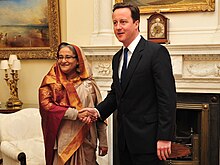
After the 1991 general election, the twelfth amendment to the constitution restored the parliamentary republic, and Begum Khaleda Zia became Bangladesh's first female prime minister. Zia, a former first lady, led a BNP government from 1990 to 1996. In 1991, her finance minister, Saifur Rahman, began a major programme to liberalise the Bangladeshi economy.[224] In addition to setting up the Chittagong Stock Exchange; banking, pharmaceuticals, aviation, ceramics, steel, telecoms, and tertiary education were opened up for investments, resulting in increased market competition. In 1992, an estimated 250,000 refugees from Burma took shelter in Bangladesh due to the suppression of the Burmese pro-democracy movement; most of these refugees returned to Burma by 1993.[219] In 1994, Bangladesh provided the largest non-US contingent in Operation Uphold Democracy, a military intervention in Haiti.[225]
In 1996, a year of political upheaval saw a boycotted February election, an attempted military coup, and mediation efforts producing a caretaker government to oversee elections. For three months, Muhammad Habibur Rahman served as the interim leader of the country. The Awami League returned to power in the June election after 21 years. One of the first initiatives of Prime Minister Sheikh Hasina was to repeal the deeply controversial Indemnity Ordinance, which protected her father's killers from prosecution. Hasina also signed the Chittagong Hill Tracts Peace Accord, which ended an insurgency in the southeastern hill districts. She reached an agreement with India for sharing the water of the Ganges.[226] In 1997, Sheikh Hasina hosted South Africa's first post-apartheid president Nelson Mandela, PLO chairman Yasser Arafat, and Turkish president Süleyman Demirel for the silver jubilee celebrations of Bangladesh's independence.[227][228]
The economic reform momentum lost steam due to political instability, including frequent hartals and strikes by the opposition. In 2001, the BNP returned to power on the back of promises to improve the economy. The second Zia administration saw higher economic growth, but security and political problems gripped the country between 2004 and 2006. A radical Islamist militant group, the JMB, carried out a series of terror attacks. At the end of the BNP's term in 2006, there was widespread political unrest. The Bangladeshi military urged President Iajuddin Ahmed to impose a state of emergency and a caretaker government, led by Fakhruddin Ahmed, was installed from January 2007 to December 2008 to implement reforms to the electoral system, judiciary, and bureaucracy.[224] The JMB leaders were arrested and later executed in March 2007.[229]
After the 2008 Bangladeshi general election, the Awami League led by Sheikh Hasina returned to power in 2009.[230] In 2010, the Supreme Court reduced the scope for military interventions through legal loopholes and reaffirmed secular principles in the constitution. In 2011, parliament abolished the caretaker system to oversee elections as part of the 15th amendment to the Constitution of Bangladesh.[231] The Awami League set up a war crimes tribunal to prosecute surviving Bengali Islamist collaborators of the 1971 atrocities. Human rights abuses increased under Hasina and her administration, particularly enforced disappearances by the Rapid Action Battalion, with the government being described as increasingly authoritarian.[232][233][234][235][236] The 2014 elections and 2024 elections were boycotted by the BNP-Jamaat alliance. The BNP and Jamaat have often engaged in violent protests to overthrow the government.[237][238] In 2017, Bangladesh experienced the largest influx of Arakanese refugees in its history. An estimated 700,000 Rohingya refugees took shelter in Cox's Bazar after a campaign of ethnic cleansing in Rakhine State, Myanmar.[239]
The national poverty rate went down from 80% in 1971 to 44.2% in 1991 to 12.9% in 2021.[240][241][242] Bangladeshi economist Muhammad Yunus and the Grameen Bank, which Yunus founded, were awarded the Nobel Peace Prize for pioneering microfinance and their efforts to eradicate poverty. Bangladesh has emerged as the second-largest economy in South Asia,[243][244] surpassing the per capita income levels of both India and Pakistan.[245][244] Since 2009, Bangladesh has launched a series of infrastructure megaprojects. On 25 June 2022, the Padma Bridge opened and connected southwestern Bangladesh with the rest of the country, while the Dhaka Metro was opened in 2023.[246][247] As part of the green transition, Bangladesh's industrial sector emerged as a leader in building green factories, with the country having the largest number of certified green factories in the world in 2023.[248] In January 2024, the Awami League led by Prime Minister Sheikh Hasina secured a fourth consecutive term in a general election boycotted by the opposition Bangladesh Nationalist Party.[249]
Geography

Bangladesh is in South Asia on the Bay of Bengal. It is surrounded almost entirely by neighbouring India, and shares a small border with Myanmar to its southeast, though it lies very close to Nepal, Bhutan, and China. The country is divided into three regions. Most of the country is dominated by the fertile Ganges Delta, the largest river delta in the world.[250] The northwest and central parts of the country are formed by the Madhupur and the Barind plateaus. The northeast and southeast are home to evergreen hill ranges.
The Ganges delta is formed by the confluence of the Ganges (local name Padma or Pôdda), Brahmaputra (Jamuna or Jomuna), and Meghna rivers and their tributaries. The Ganges unites with the Jamuna (main channel of the Brahmaputra) and later join the Meghna, finally flowing into the Bay of Bengal. Bangladesh is called the "Land of Rivers";[251] as it is home to over 57 trans-boundary rivers, the most of any nation-state. Water issues are hence politically complicated since the country is a lower riparian state to India.[252]
Bangladesh is predominantly rich fertile flat land. Most of it is less than 12 m (39 ft) above sea level, and it is estimated that about 10% of its land would be flooded if the sea level were to rise by 1 m (3.3 ft).[253] 17% of the country is covered by forests and 12% is covered by hill systems. The country's haor wetlands are of significance to global environmental science. The highest point in Bangladesh is the Saka Haphong, located near the border with Myanmar, with an elevation of 1,064 m (3,491 ft).[254] Previously, either Keokradong or Tazing Dong were considered the highest.
Administrative divisions
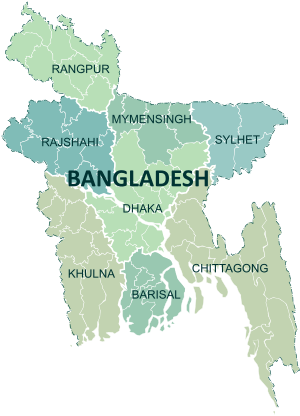
Bangladesh is divided into eight administrative divisions,[255][254][256] each named after their respective divisional headquarters: Barisal (officially Barishal[257]), Chittagong (officially Chattogram[257]), Dhaka, Khulna, Mymensingh, Rajshahi, Rangpur, and Sylhet.
Divisions are subdivided into districts (zila). There are 64 districts in Bangladesh, each further subdivided into upazila (subdistricts) or thana. The area within each police station, except for those in metropolitan areas, is divided into several unions, with each union consisting of multiple villages. In the metropolitan areas, police stations are divided into wards, further divided into mahallas.
There are no elected officials at the divisional or district levels, and the administration is composed only of government officials. Direct elections are held in each union (or ward) for a chairperson and several members. In 1997, a parliamentary act was passed to reserve three seats (out of 12) in every union for female candidates.[258]



